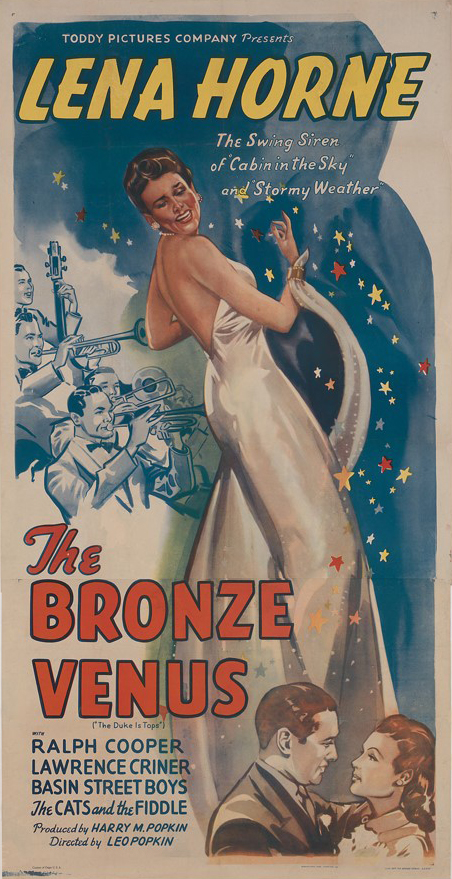Lena Horne on the Big Screen

Lena Horne is best known today as one of the greatest song stylists of the twentieth century, recipient of four Grammies (which included a lifetime achievement award) and numerous honors. Early in her career, Horne's magnificent vocal styling and compelling stage presence launched her short-lived career in film. This 1943 film poster documents Horne's rapid rise to cinematic fame, but also hints at the limitations placed on her as an African American performer in mid-twentieth-century America.
Horne began her career as a sixteen-year-old chorus dancer at Harlem's Cotton Club and swiftly moved on to become the featured singer at a number of Manhattan nightclubs. She made her first onscreen appearance at the age of twenty-one in the 1938 film The Duke is Tops. Billed as a "swing musical sensation," the film tells the story of a small-time variety show promoter, Duke Davis, who sacrifices his own professional and romantic interests so that his talented young ingénue and love interest, nicknamed "the Bronze Nightingale," can abandon him to pursue success on Broadway. The starring role of Duke was performed by the well-known bandleader, emcee, and dancer Ralph Cooper, the charismatic host of Amateur Night at Harlem's Apollo Theater from 1935 to 1985. With the dream of breaking into films, Cooper co-founded the company Million Dollar Productions in 1937 to create star vehicles for himself, featuring all-black casts and aimed at African American audiences.
The Duke is Tops was one of the first films created by Million Dollar Productions, and Cooper tapped Lena Horne to play opposite him as "the Bronze Nightingale." Horne had been living in semi-retirement in Pittsburgh after giving birth to her first child, but she jumped at the chance to try her luck in Hollywood. A mere ten days had been allotted for the film's production, but the shoestring budget did not last even that long. Rather than abandon this rare opportunity to demonstrate their talents on the big screen, Horne and the other cast members worked without pay. The resulting film features dynamic performances by once-popular acts that are now little remembered: dancer Rubberneck Holmes, known for his anatomy-defying elasticity and jazz vocal group The Cats and the Fiddle, appearing a year before they were officially "discovered" by Victor Records. The film also features a comic turn by Laurence Criner, one of the most popular African American actors of his day. But it is Horne's musical numbers that steal the show.
Horne's nightclub performances were equally mesmerizing, and she eventually attracted the attention of the film studio Metro-Goldwin-Mayer. In 1942 MGM signed her to a seven-year picture deal—only the second time in history that an African American woman had been offered a long-term movie contract. The mainstream popularity of two films she made with all-black casts in 1943—Cabin in the Sky and Stormy Weather—prompted the re-release of The Duke is Tops that same year. To capitalize on Horne's stardom, the film was retitled The Bronze Venus, drawing attention to her beauty as well as her skin color. The film's promotional poster makes the most of Horne's glamor, showing her in a shimmering white satin gown against a midnight blue backdrop spangled with stars. Her name receives top billing in bright yellow letters at the top of the sheet, while the name of the film's original star, Ralph Cooper, is relegated to the bottom in small black letters.
Horne invariably played prominent roles in films featuring all-black casts, but in her seven MGM films with predominantly white casts, she was restricted to the periphery, appearing in stand-alone musical sequences with little impact on the narrative. This was so that Horne's scenes could be edited out of versions shown in the south, where movie theaters upheld a segregationist policy against films featuring black performers. As Horne later recalled, "No one bothered to put me in a movie where I talked to anybody, where some thread of the story might be broken if I were cut." The racial prejudice that limited Horne's acting career disillusioned her with filmmaking and she made no more movies with MGM after 1946.
As a singer, too, Horne faced persistent racial discrimination, frequently barred from hotels and restaurants. These experiences fired Horne's commitment to civil rights activism, which began in the 1940s. While performing with the USO during World War II, she was outraged to see African American soldiers forced to sit behind German prisoners-of-war. When she complained, MGM removed her from the tour, but Horne continued anyway—using her own money to fund performances for black soldiers. After the war, she worked on behalf of Japanese Americans facing discriminatory housing practices. She assisted Eleanor Roosevelt with her campaign for anti-lynching legislation. She participated in the March on Washington in 1963 and worked on behalf of the National Council of Negro Women (NCNW), the Student Nonviolent Coordinating Committee (SNCC), the National Association for the Advancement of Colored People (NAACP), and many other social justice organizations.
Lena Horne not only blazed a trail for African American entertainers by overcoming racial prejudice to achieve mainstream popularity as a singer and actor. She also set a universal example of a life fully lived, combining extraordinary artistry with full-throated political engagement. In recognition of her lifetime of achievement on many fronts, she received a Kennedy Center Honors Award in 1989 for "extraordinary talent, creativity, and perseverance."